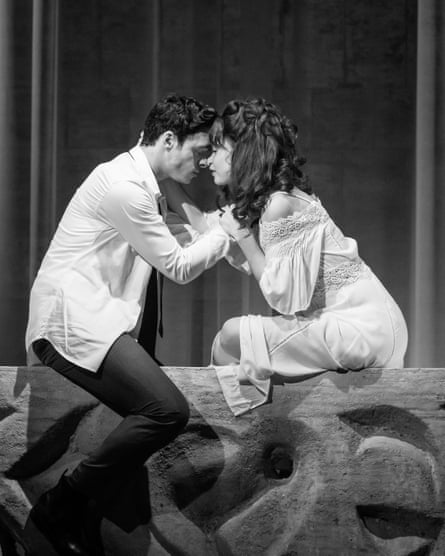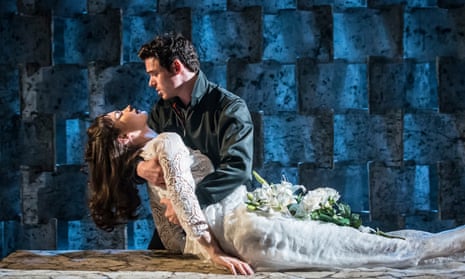It has, in the past, taken all too little encouragement for me to express my bad-tempered and contradictory views concerning the theatre: namely, that it is pricey and divisive compared to cinema’s democracy; and furthermore, that livestreaming theatrical events into cinemas is gimmicky and a pale reflection of the flesh-and-blood experience (which I have only just finished slagging off as pricey, divisive, etc).
So, in an attempt to kill both bees in my bonnet at the same time, the Garrick theatre in London’s West End and the Picturehouse cinema group challenged me to an experiment. I would watch the first half of Kenneth Branagh’s production of Romeo and Juliet in the theatre. And then at the interval, instead of settling down in the snug bar with a G&T in the traditional manner, my wife and I would exit the theatre and be hustled across town, with motorcycle outriders if necessary, to watch the second half in the cinema.
I’ve got to admit it – this was a revelation. In the first half, I found myself really enjoying the openness, candour and freshness of Branagh’s production, which my colleague Michael Billington praised for its “pulsating energy”. Lily James is a black-belt Shakespearian actor in the role of Juliet, while her former screen Cinderella co-star Richard Madden is winning and winsome as Romeo; Meera Syal gets some big laughs as the Nurse, and Derek Jacobi is tremendous left-field casting as Mercutio, an ageing queeny guy who still likes hanging out with young men and, with a drop taken, fancies himself as a brawler. (Branagh was reportedly inspired by DH and Frieda Lawrence’s encounter with an inebriated Oscar Wilde.)

As ever, when I see a Shakespeare production, I am struck by how much I remember from schooldays, but how little I actually understood at the time. And how is it possible that I have only now noticed the resemblance between the Queen Mab speech and that comparable set piece, the Seven Ages of Man monologue from As You Like It? How have I thus far missed the resemblance between Lady Capulet telling Juliet to buck up and stop moping and Gertrude saying the same thing to Hamlet?
But anyway, I enjoyed the various Italianate touches: period frocks and Vespas that appeared to come from the Fellini 1960s, though the electropop party sequence was surely inspired by Paolo Sorrentino’s 2013 film The Great Beauty.
Once in the cinema for the second half, though, various things dawned on me. I hadn’t realised that the livestream was going to be in black and white. After a little while, I grasped this was an intentional directorial touch, an explicit reference to the cinema of Antonioni and Fellini, an extra layer of interpretation unavailable to theatregoers. The problem was that the monochrome didn’t look like film. It reminded me of TV from the 50s and 60s – the age when you could watch high-risk live productions of stage plays. There is no danger of Acorn Antiques-style scenery wobble. Everything runs smoothly. But I think they could have transmitted in colour and we would still have appreciated the filmic touches.
The differences were weirdly and immediately obvious. On the cinema screen, the set looked gigantic in a way that it hadn’t in the theatre. It was like something for Wagner’s Twilight of the Gods. In the theatre, I was aware of the audience somehow crowding and bristling intently forward to the edge of the stage. In the cinema, the audience are absent until the end, when the sharp clatter of applause comes as a surprise.
And there was something at once relaxing and yet coercive about the syntax of the screen: the wide-shot, the closeup, the occasional slow zoom to emphasise a speech’s crescendo. You are being told what to see and when to see it. My first-half theatregoer brain resented that a bit. But then I appreciated things I hadn’t before the interval. For example: Romeo, Juliet and Lord Capulet wear exactly matching tiny crucifixes round their necks … hinting at a dysfunctional emotional triangle, perhaps? Intriguing. The death scene was presented in the cinema with a big overhead shot. You lose, I think, the pure concentration on the poetry in the cinema, but gain in the visual sense, as the unitary view of the proscenium arch is broken and reframed over and over.
Actually, I think I have been thinking about this the wrong way. Instead of worrying about it as culture, how about comparing it to sport? I had left Centre Court and taken up my position on Murray Mound. And being on Murray Mound turned out to be pretty exciting. People watching a football match on TV as opposed to in the stadium can still have a great time – without worrying that it’s inauthentic, or that they have somehow made a wrong or disloyal choice. And, as my wife pointed out to me, at concerts and festivals, there are always screens. Screens are now part of the live experience.
That moment when Juliet died was the moment of my Damascene conversion. Livestreaming is opening up theatre to new audiences. It’s a boost to cinemas and probably stimulating theatre ticket sales as well. So I’m converted.
- Romeo and Juliet is at the Garrick theatre, London, until 13 August and livestreamed in cinemas on 14 August. Buy theatre tickets from the Guardian Box Office. Telephone: 0330-333 6906.

Comments (…)
Sign in or create your Guardian account to join the discussion